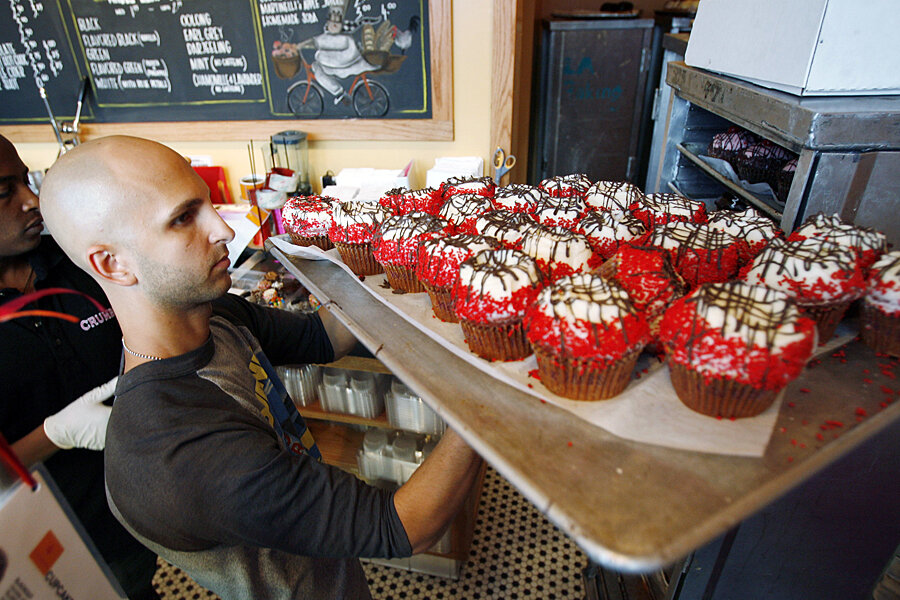Crumbs Bake Shop closing all stores. Is the cupcake craze crumbling?
That's the way the cupcake crumbles, as they say. (Sort of).
Crumbs, the nationwide chain known for its gourmet cupcakes, has abruptly closed its doors. The company notified employees that the business is ceasing operations at all 48 stores in 10 states and the District of Columbia, according to a report from the Wall Street Journal. A Crumbs spokeswoman told the WSJ that the company is evaluating its remaining options – one of which is filing for bankruptcy.
Crumbs opened its first shop on the Upper West Side of Manhattan in March 2003. In 2011, Crumbs went public as the cupcake trend was booming. But in the intervening years, high operating costs and expensive cupcakes’ decline in popularity contributed to Crumbs’ financial downfall. The Nasdaq Stock Market suspended trading of Crumbs on July 1 because the company failed to either having at least $2.5 million in shareholder equity or meeting benchmarks for its market cap or annual net profit. However, the Nasdaq still listed Crumbs under its ticker ‘CRMB’ at $0.04 a share Tuesday morning.
Cupcakes started to become very popular to serve in restaurants about five or six years ago, says Darren Tristano, executive vice president at Technomic Inc., a Chicago research and consulting firm that specializes in the food industry. Gourmet cupcakes started to trend when popular HBO TV show "Sex and the City" featured New York’s Magnolia Bakery, he says in a phone interview with the Monitor. That is when people started to take a serious look at the $5 cupcake.
However, this high-end product appeals to a small, affluent demographic, points out Bonnie Riggs, a restaurant industry analyst from NPD Group. Places like Crumbs aren’t for the average consumer because of the high prices, she says.
“You’re not going to take your kids there to go out and eat…unless you’re affluent,” Ms. Riggs says. For example, if parents want to treat their children to places like Crumbs, it would costs $30 for a cupcake and beverage for everyone, she adds.
So, if the cupcake is out, what will replace it as the king of trendy desserts? Consumers are starting to see more ‘mash-ups’ with food, Tristano says. For example, the cronut, a crossover of a crossaint and a donut, has gained a cult following in Dominique Ansel Bakery in New York. Another contender: the waffnut, the lovechild of a waffle and a donut.
However, these trends do not translate to successful business models, Riggs argues. There is always a fad that people want to try, she says, but unless a business can have customers keep coming back after the novelty has worn off, the business won’t sustain itself. Typically, one third of a food business's customersis responsible for 60 percent of its purchases, Riggs adds. That means repeat visits are the lifeblood of a sustainable restaurant concept. Another problem is these niche foods, like the cronut, are focused in such small markets and appeal to a small, specific demographic that businesses serving those foods have to find a way to expand their customer base in order to succeed on a larger scale, she says.
Furthermore, there has been a trend from younger consumers moving toward healthier snacking, which traffic away from cupcakes, both Riggs and Mr. Tristano say. Riggs says she sees more salad-type places with healthy options to go.
But with the decline of Crumbs, people cannot point to one major cause, Tristano says. Competition, other indulgent sweets, supermarkets, and a shift of consumers eating more at home are also factors into Crumbs’ demise. Another issue: the idea of being singularly-focused and such a niche market. That is especially true for more dessert-like foods, although frozen yogurt is still trucking along.
“[Frozen yogurt] has greater variety, it is healthier, and it is at about the same price,” Tristano says. “But even frozen yogurt to some extent is struggling.”
Similar to cupcakes, the frozen yogurt market is oversaturated, Rigg says. To stay in business, frozen yogurt places need repeat customers and less sticker shock, she says.
Broadening menus can help stores selling niche-products like gourmet cupcakes, Tristano adds. Red Mango and Pinkberry, two popular frozen yogurt chains, have added breakfast and Greek non-frozen yogurt, he says. To avoid Crumbs’ fate, other cupcake stores will need to add more to their menus like coffee and other beverages, and keep their overhead costs low, such as having smaller shops.
“Some [cupcake shops] will remain open and see a bulk of Crumbs’ traffic shift toward them and make them more profitable,” Tristano says. However, it could be a smart move to get out while it is good, especially with trendier products, he adds.






